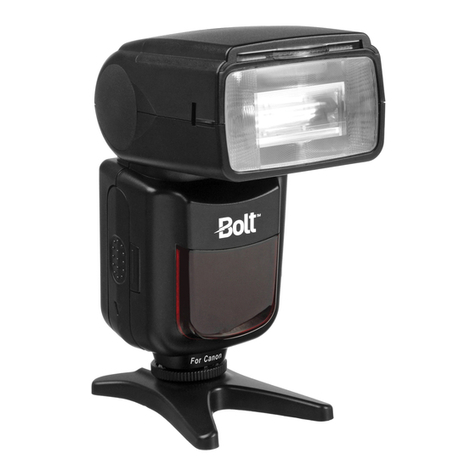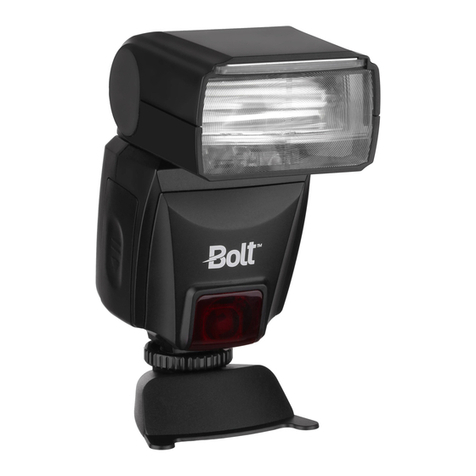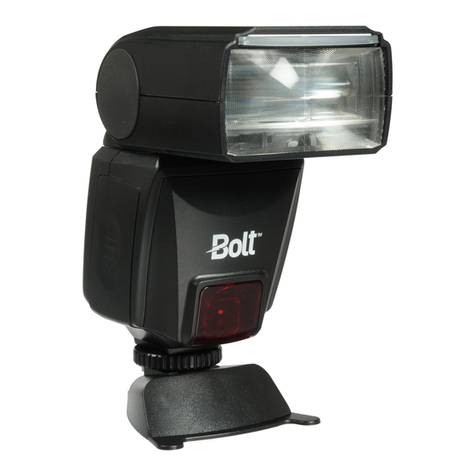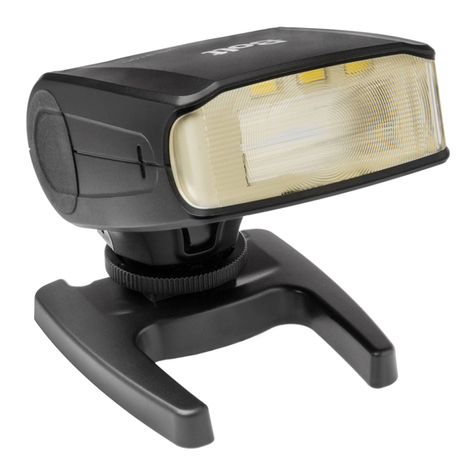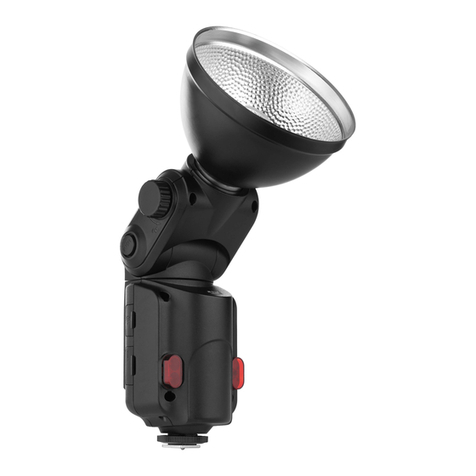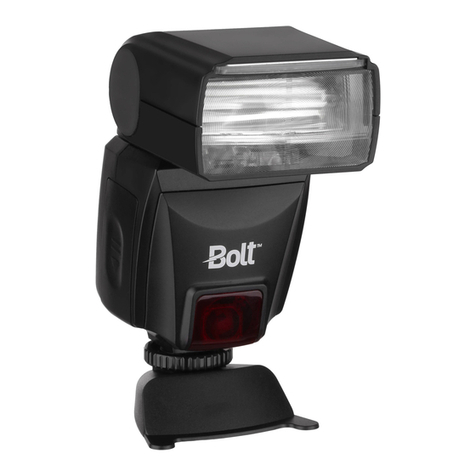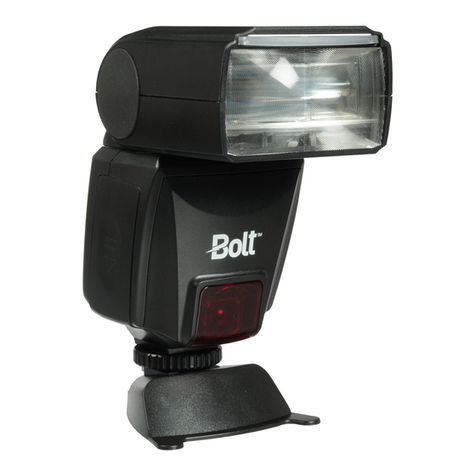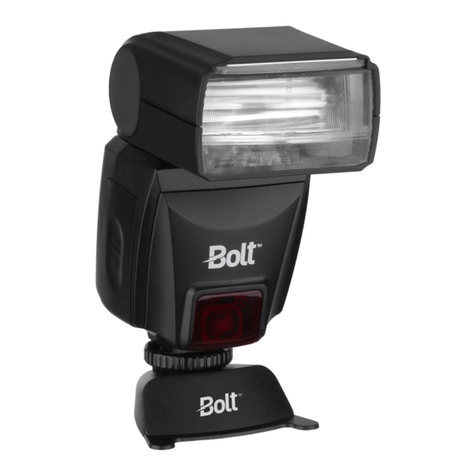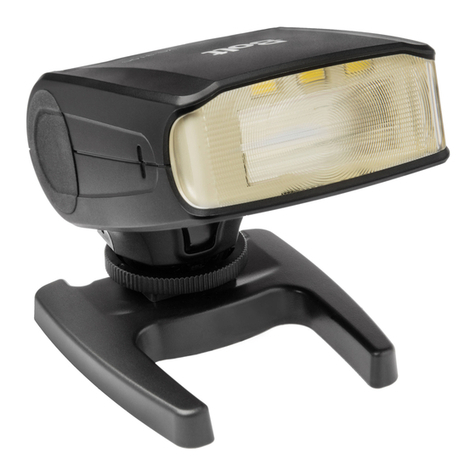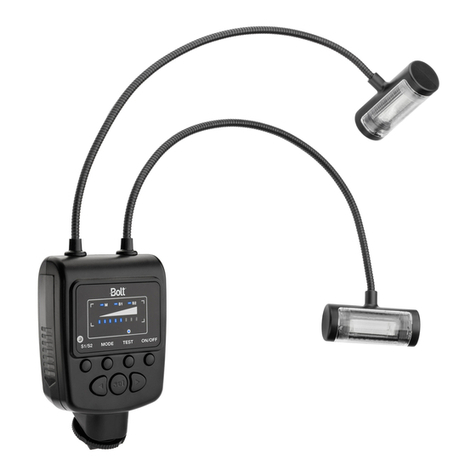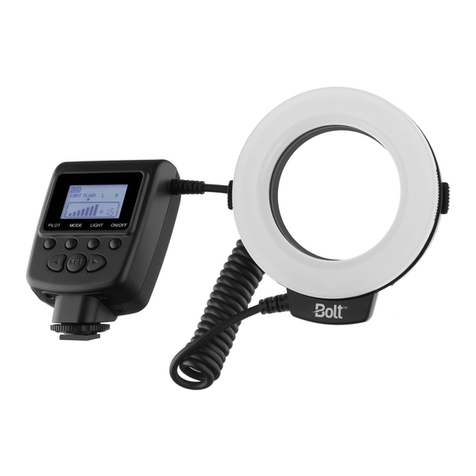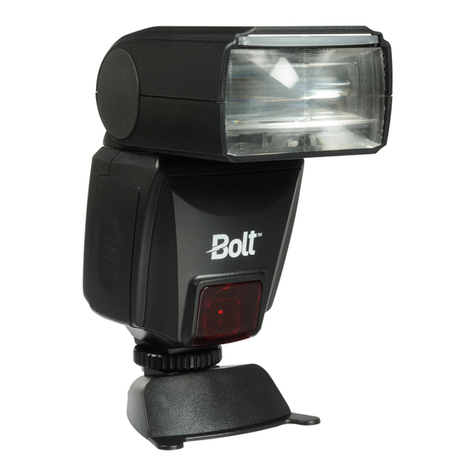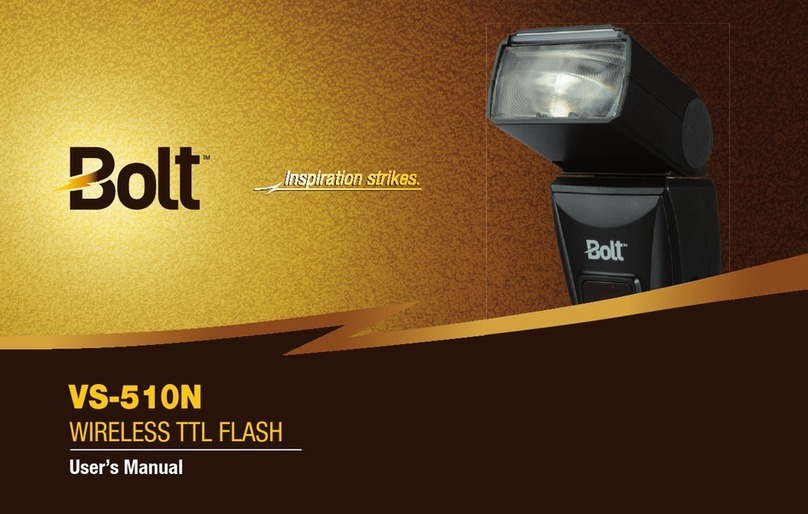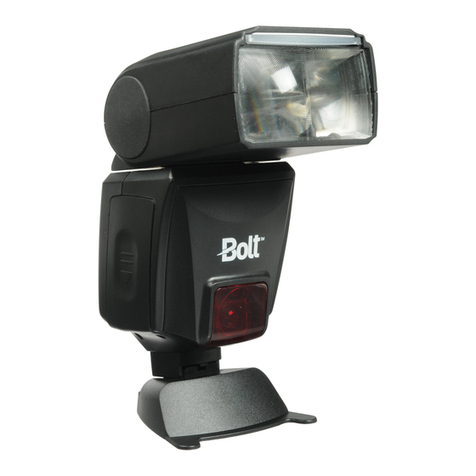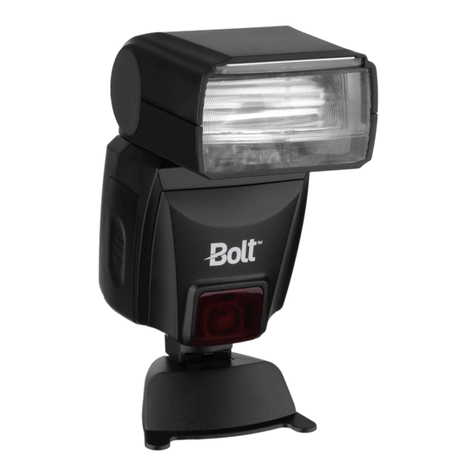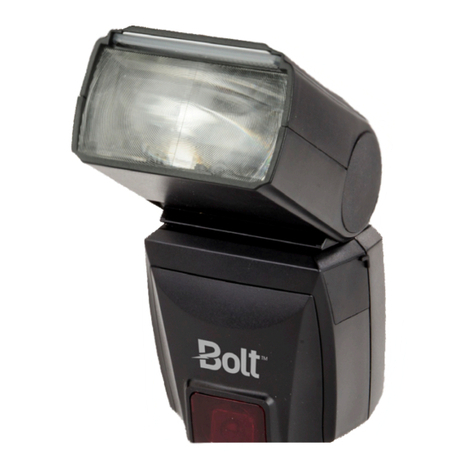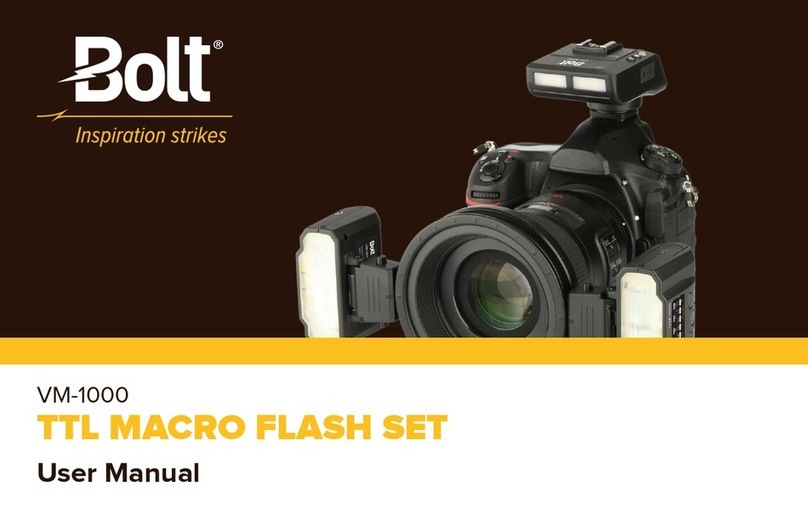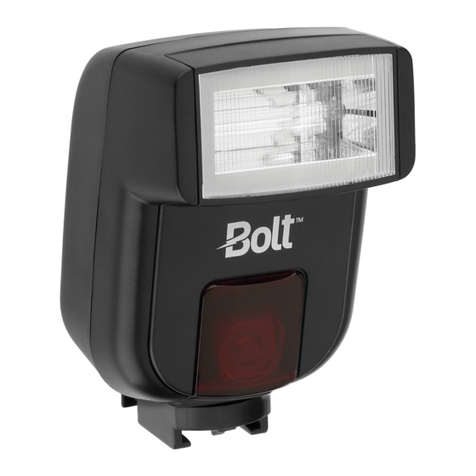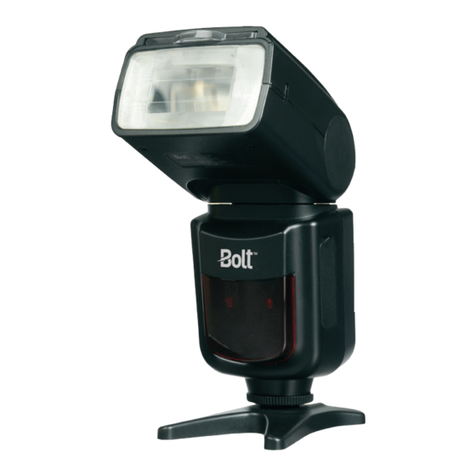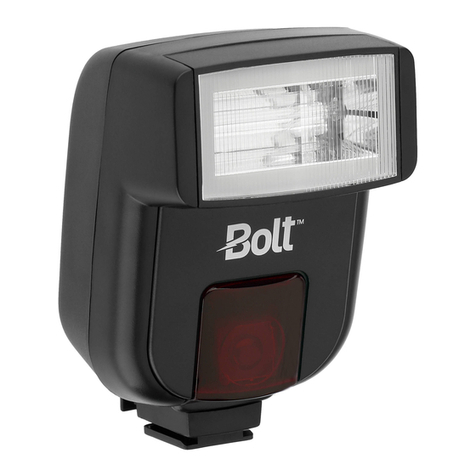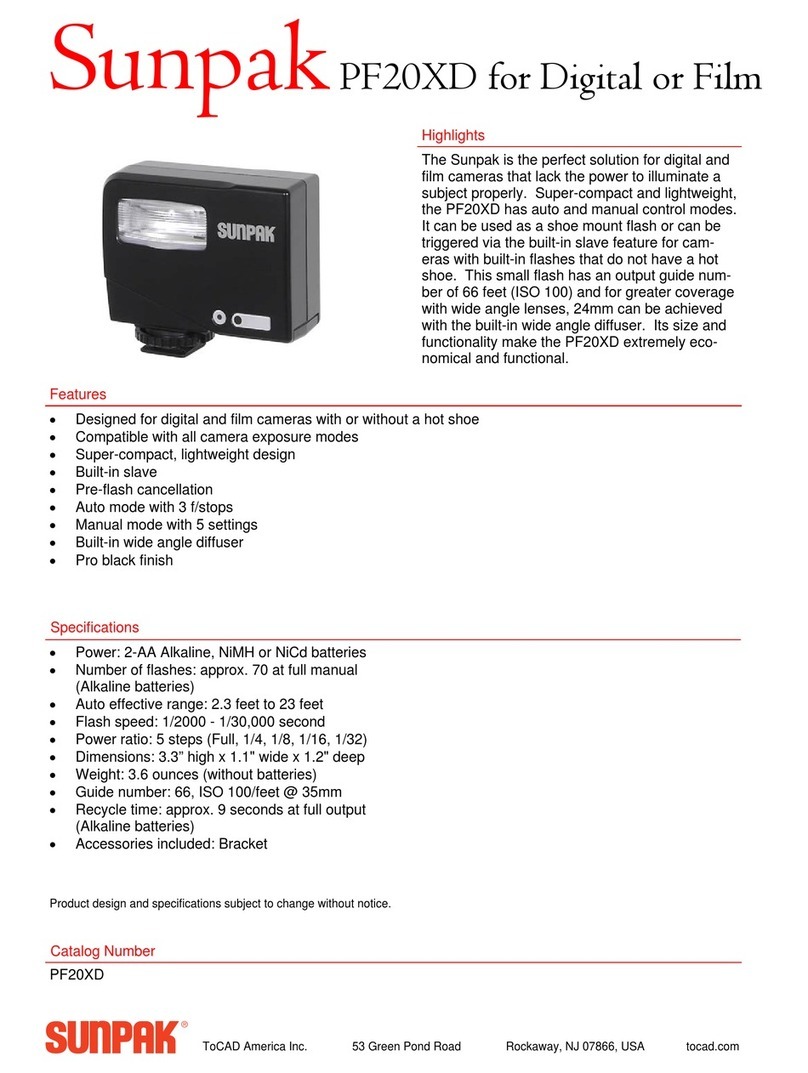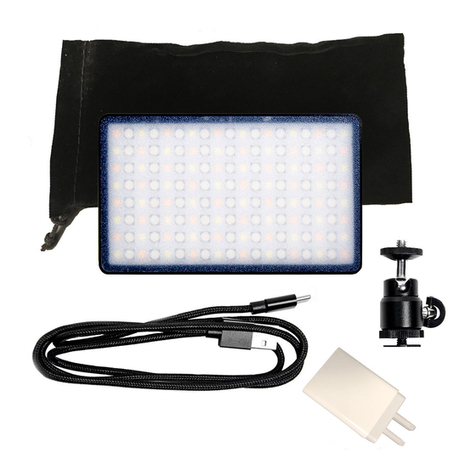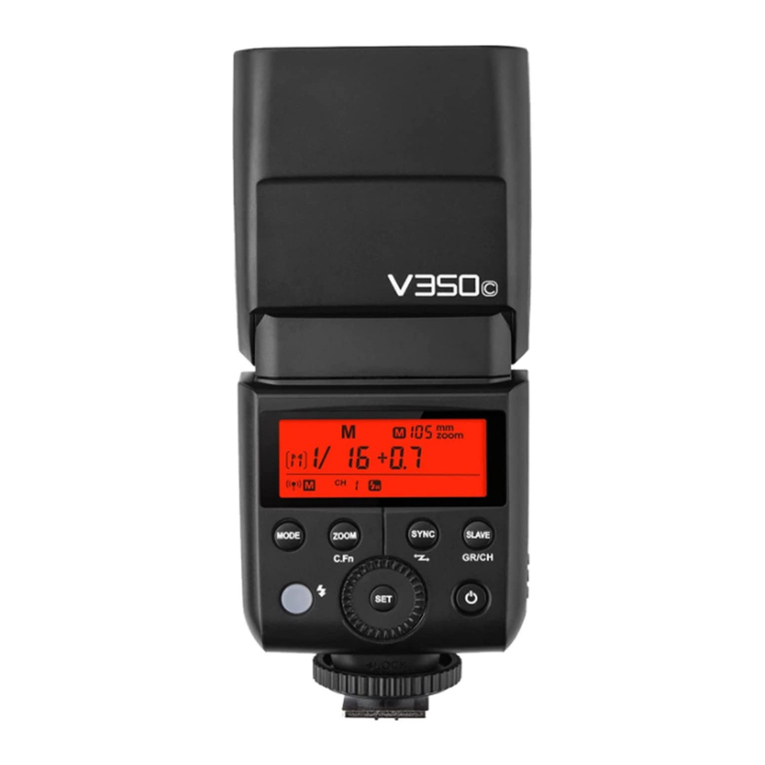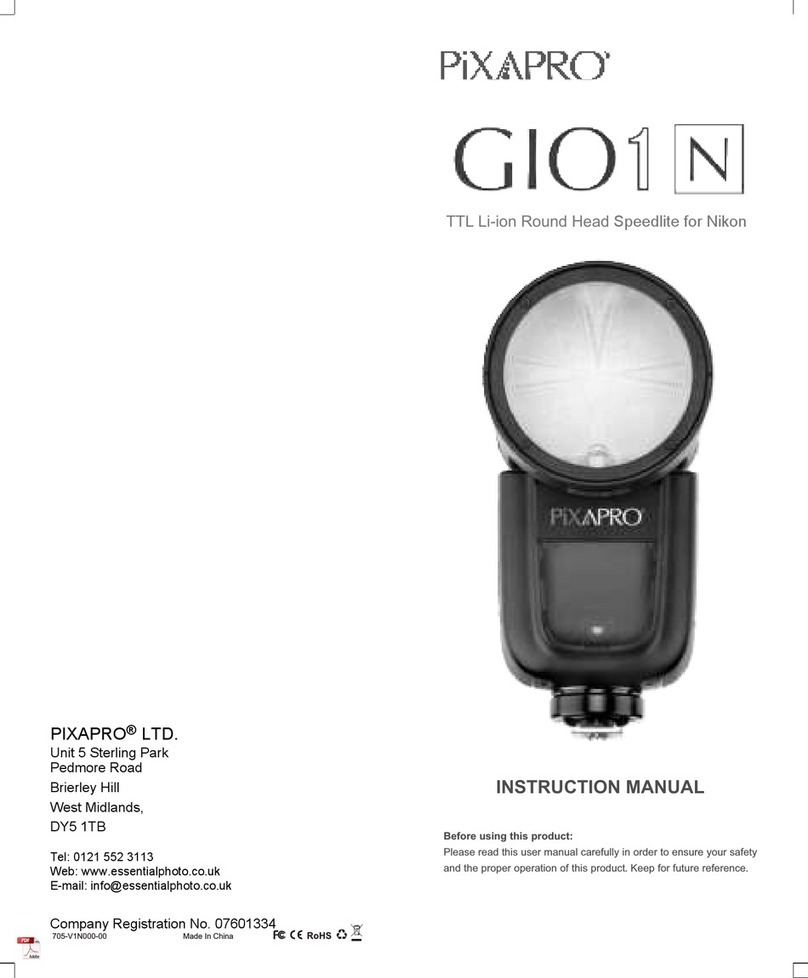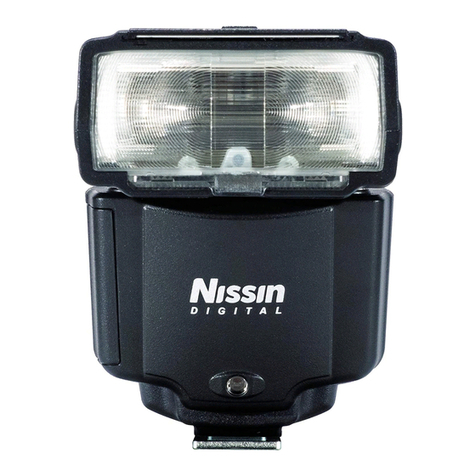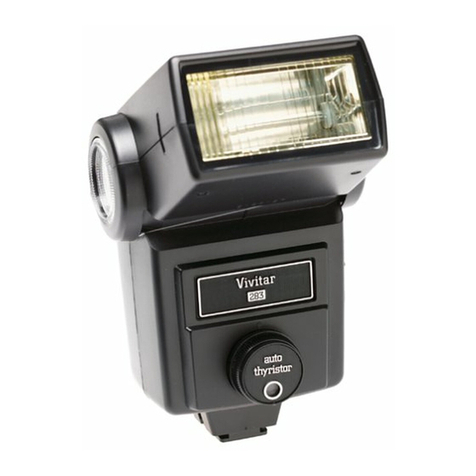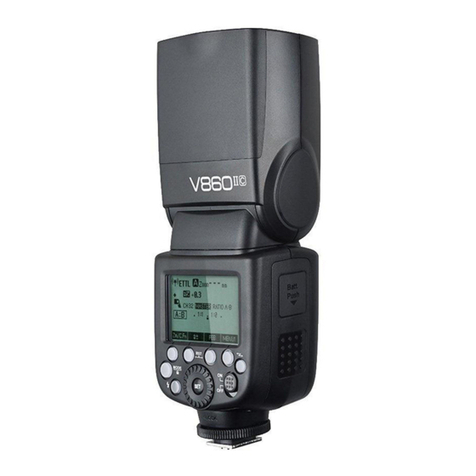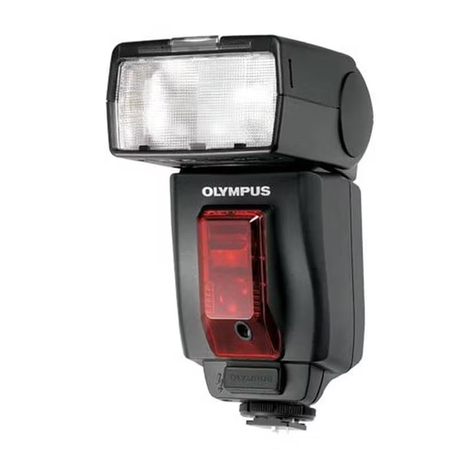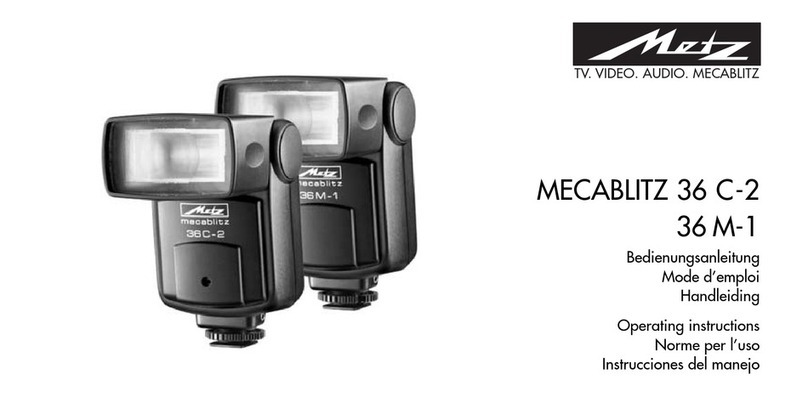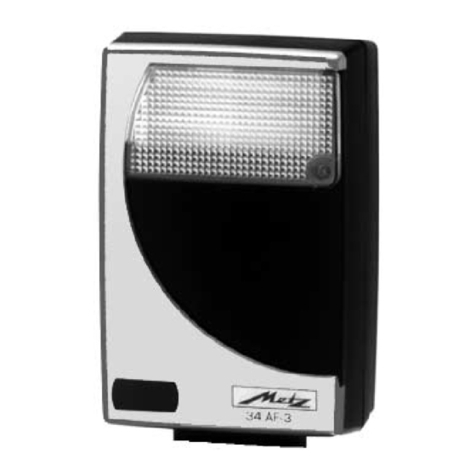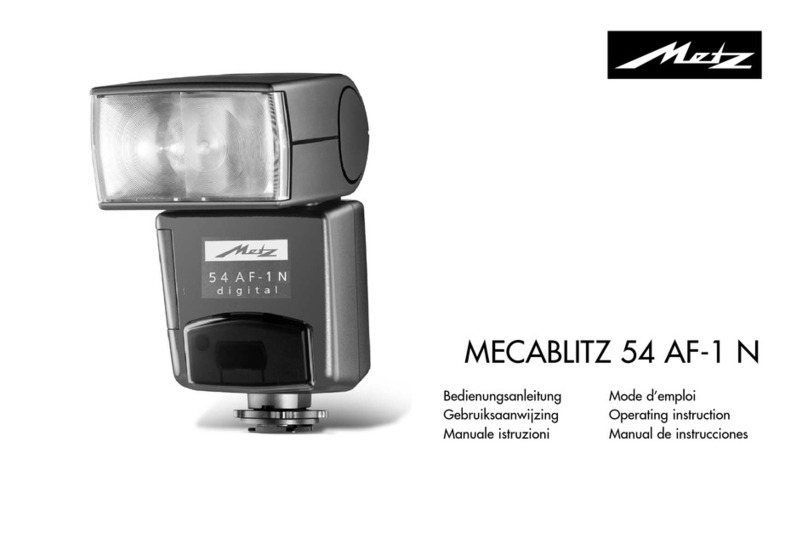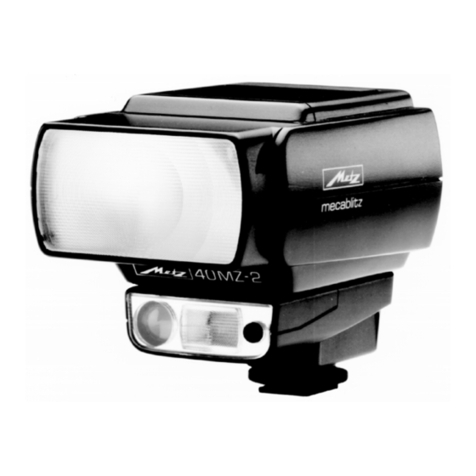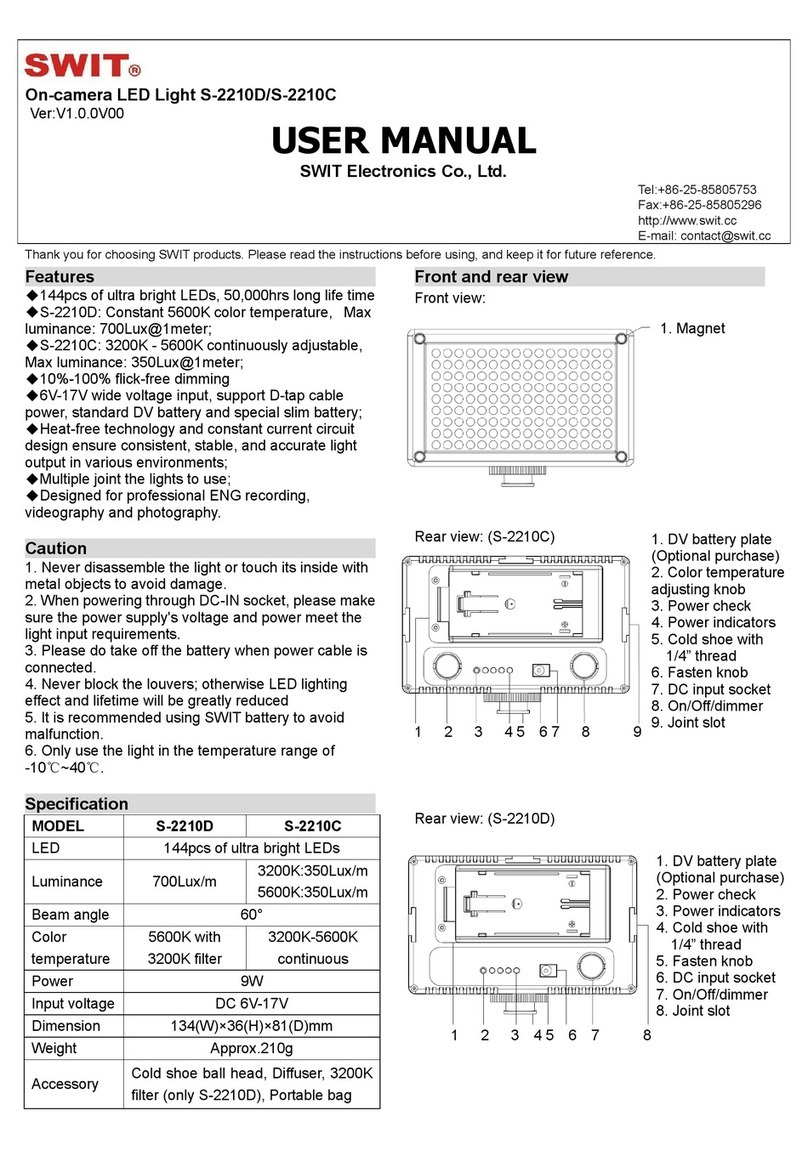Bolt VS-210 User manual

VS-210
FLASH
User’s Manual
Inspiration strikes.
Inspiration strikes.

2 |Introduction
Copyright © 2012 Gradus Group.
Bolt and other names of Bolt products are trademarks of Gradus Group. Other product and corporate names mentioned herein are trademarks of their respective holders.

Introduction |3
Introduction
Thank you for choosing the Bolt VS-210.
This compact electronic ash unit can be
used with both lm and digital cameras.
Among the benets you’ll enjoy:
• Choice of manual control or easy
automatic ash
• Adjustable ve-position ash head
• Sync socket for off-camera ash
positioning

4 |Contents

Contents |5
Contents
Overview .................................................................................................................................................... 6–7
Warnings .................................................................................................................................................. 8–10
Installing Batteries .................................................................................................................................. 10–11
Mounting the Flash ................................................................................................................................. 12–13
Turning on the Flash and Firing a Test ........................................................................................................... 14
Using the Manual Flash Mode ................................................................................................................. 14–15
Reading the Exposure Chart .................................................................................................................... 16–17
Using an Automatic Flash Mode .............................................................................................................. 18–19
Bouncing Your Flash ................................................................................................................................ 19–20
Troubleshooting ............................................................................................................................................ 21
Specications ............................................................................................................................................... 22
Warranty........................................................................................................................................................ 23

6 |Overview
TEST/
1.6 2.3 3.2 4.5 6.4 913 18
5.2 7.5 11 15 21 30 43 59
m
ft
25
50
100
200
400
2.8
2
4
5.6
8
11
16
22
LOCK
READY OFF
ON
AUTO OK
2
4
1
7
10
6
9
4
8
5
2
3

Overview |7
Overview
1. Flash head
2. Auto sensor
3. Battery compartment
cover
4. Exposure table
5. Mounting foot
6. Mounting foot lock
7. Test button / Ready light
8. Power switch / Mode
selector
9. Automatic exposure
conrmation light
10. Sync socket
11. Sync cord
11

8 |Warnings
Warnings
Before using your VS-210, please read the following safety notices carefully and thoroughly to ensure safe use,
and to help prevent damage to your ash or injury to yourself or others.
• Do not re the ash at close range directly into the eyes of people or animals. This can cause damage to
the retina and may even lead to blindness.
• To avoid overheating and damaging your ash unit, please wait for at least 10 minutes after 20 continuous
ashes at full power.
• Do not disassemble or attempt to repair this product yourself. There are high-voltage components inside
that can produce a hazardous electric shock.
• Keep this product and its batteries out of reach of children.
• Use only the power sources specied in this manual.
• Always switch the ash off before changing the batteries.
• Always install AA batteries of the same type, brand, and age. Do not combine different types or brands, or
old and new batteries. This could cause batteries to leak, overheat, or explode.
• Install batteries in the proper orientation, according to the indicator in the battery chamber. Installing
batteries in the reverse orientation could cause them to leak, overheat, or explode.

Warnings |9
• Do not use or store the VS-210 in ammable conditions (such as environments containing ammable gases
or liquid chemicals). This could damage the ash, start a re, or cause an electric shock.
• Do not clean the VS-210 with agents containing corrosive or ammable substances such as paint thinner,
benzene, or nail polish remover.
• This product is not water resistant. Keep it away from rain, snow, humidity, and general moisture.
• Should the VS-210 get damaged, do not touch any exposed interior metal parts. If touched, they may
generate an electric shock or cause a malfunction. Promptly remove the batteries and take the product to
an authorized service center for repair.
• If you detect excessive heat, smoke, or a burning smell coming from the ash, immediately stop operation
and remove the batteries to prevent the product from igniting or melting. Take the product to an authorized
service center for repair.
• Do not touch the VS-210 with wet hands, as this may generate an electric shock.
• Do not drop or otherwise cause a strong physical impact to the VS-210, as this could cause a malfunction
that may cause it to explode or ignite.
• Remove all batteries from the VS-210 before long-term storage in order to prevent the product from igniting
or leaking corrosive liquids.
• Do not store or use this product at temperatures above 40°C / 104°F.

10 |Installing Batteries
• Keep the metal contacts in the battery compartment clean and free of corrosion and dirt. Do not touch
them with your ngers. Corrosive elements on the contacts can damage the VS-210 and prevent it from
functioning properly. Contacts may be cleaned with isopropyl alcohol on a cotton swab.
• Dispose of used batteries properly. Never heat them or throw them into a re, as this could cause the
batteries to leak corrosive liquids, generate heat, or explode.
Installing Batteries
The VS-210 can be powered by two AA batteries of several types:
• Lithium (1.5V)
• Nickel-metal hydride (Ni-MH) (1.2V)
• Alkaline (1.5V)
Note: For the fastest recycle times and longest battery life, lithium and Ni-MH batteries are recommended.

Installing Batteries |11
To install batteries, make sure the VS-210 is turned off and follow these steps:
1. Press on the battery compartment cover and slide it in the direction of the arrow to remove it.
2. Insert batteries in the orientations indicated inside the compartment.
3. Replace the battery compartment cover by pressing and sliding it into place, in the opposite direction of
the arrow on the cover.
Important!
Replace both batteries at the same time. Do not mix battery types or brands, or use old and new batteries
together.
1.6 2.3 3.2 4.5 6.4 913 18
5.2 7.5 11 15 21 30 43 59
m
ft
2.8
2
4
5.6
8
11
16
22
LOCK
AUTO OK
4
1.6
2.3
3.2
4.5
6.4
9
13
18
5.2
7.5
11
15
21
30
43
59
m
ft
2.8
2
4
5.6
8
11
16
22
LOCK
AUTO OK
4
LOCK
LOCK
ON
AUTO OK
1.6 2.3 3.2 4.5 6.4 913 18
5.2 7.5 11 15 21 30 43 59
m
ft
2.8
2
4
5.6
1.6
2.3
3.2
4.5
6.4
9
13
18
5.2
7.5
11
15
21
30
43
59
m
ft
2.8
2
4
5.6
1.6 2.3 3.2 4.5 6.4 913 18
5.2 7.5 11 15 21 30 43 59
m
ft
2.8
2
4
5.6
8
11
16
22
AUTO OK
1.6
2.3
3.2
4.5
6.4
9
13
18
5.2
7.5
11
15
21
30
43
59
m
ft
2.8
2
4
5.6
8
11
16
22
AUTO OK
AUTO OK
1 2 3

12 |Mounting the Flash
Mounting the Flash
To mount the VS-210 on your camera, turn it off and follow these steps:
1. Slide the mounting foot lock switch to the right to unlock it, and then slide the ash unit all the way into
your camera’s hot shoe.
2. Slide the mounting foot lock switch to the left to lock it.
TEST/
1.6 2.3 3.2 4.5 6.4 913 18
5.2 7.5 11 15 21 30 43 59
m
ft
25
50
100
200
400
2.8
2
4
5.6
8
11
16
22
LOCK
READY OFF
ON
AUTO OK
2
4
18 m
TEST/
1.6 2.3 3.2 4.5 6.4 913
5.2 7.5 11 15 21 30 43 59 ft
25
50
100
200
400
2.8
2
4
5.6
8
11
16
22
LOCK
READY OFF
ON
AUTO OK
2
4
1 2

Mounting the Flash |13
Dismounting the VS-210:
1. Turn the ash off.
2. Slide the mounting foot lock switch to the right
to unlock it.
3. Slide the mounting foot out of your camera’s
hot shoe.
Using a sync cord: If you prefer to position the ash
off-camera, you can connect it to the camera with
a ash sync cord. To do this, insert one end of the
cord into the VS-210‘s sync socket and the other into
your camera’s PC sync socket or another compatible
port. Using a ash sync cord will allow the ash to
synchronize exposures with the camera.
TEST/
1.6 2.3 3.2 4.5 6.4 913 18
5.2 7.5 11 15 21 30 43 59
m
ft
25
50
100
200
400
2.8
2
4
5.6
8
11
16
22
LOCK
READY OFF
ON
AUTO OK
2
4

14 |Turning on the Flash and Firing a Test
Turning on the Flash and Firing a Test
To turn the ash on, slide the mode selector to the On, 2, or 4 position.
When the ash is ready to re, the Ready light will glow red.
To re a test ash, press the Test button / Ready light.
Using the Manual Flash Mode
You can set ash exposures manually with the VS-210. In manual mode, the ash res at its full power. To use
manual mode, follow these steps:

Using the Manual Flash Mode |15
1. Set the mode selector to On.
2. Set your camera to either manual or aperture-priority mode.
3. Set the exposure on your camera. The correct exposure can be determined two ways:
A. By using the exposure chart on the back of the VS-210 (see below)
B. By ring a test ash and metering it with a handheld light meter. Refer to your light meter’s manual
for the correct metering procedure.
4. Press your camera’s shutter-release button to take the picture.
Note: When setting the shutter speed in manual mode, the setting will only affect the background. Using a
slower shutter will make the background behind your subject brighter and increase background or motion blur,
while a faster shutter will keep the background sharp but make it appear darker if it is beyond the ash range.
Do not set the shutter speed faster than your camera’s maximum sync speed, or black bars might appear in
your images. Refer to your camera’s manual for more information about this.

16 |Reading the Exposure Chart
Reading the Exposure Chart
The chart on the back of the VS-210 allows you to determine the correct camera settings and ash-to-subject
distance for ash exposures. You can use the chart to determine exposure in three ways:
1. By aperture and ash-to-subject distance:
A. Select the aperture you want to use on the right side of the chart.
B. Follow its horizontal line until it intersects with the vertical line of the ash-to-subject distance you want to use.
C. Follow the diagonal line at the intersection down to the ISO/ASA number at the left of the chart.
D. Set your digital camera’s ISO setting to the number indicated by the diagonal line, or use lm that
has the indicated ISO/ASA speed.
2. By aperture and ISO:
A. Select the aperture you want to use on the right side of the chart.
B. Follow its horizontal line until it intersects with the diagonal line of the ISO/ASA setting you want to use.
C. Follow the vertical line at the intersection up to the ash-to-subject-distance scale at the top of the chart.
D. Position your subject at the distance indicated by the vertical line

Reading the Exposure Chart |17
3. By ash-to-subject distance and ISO:
A. Select the ash-to-subject distance you want to use on the top of the chart.
B. Follow its vertical line until it intersects with the diagonal line of the ISO/ASA setting you want to use.
C. Follow the horizontal line at the intersection over to the aperture setting on the right of the chart.
D. Set the f-stop indicated by the horizontal line on your camera.
Using the guide number to calculate exposure: The VS-210’s guide number is 72 feet / 22 meters at
ISO 100. You can use this to calculate the
appropriate aperture setting with this formula:
Aperture (f-stop) = guide number / ash-to-
subject distance.
For example, if your subject is 6 feet away, your
aperture should be f/12 (or the closest full stop,
f/11), since 12 = 72 / 6.
1.6
2.3 3.2 4.5 6.4 9 13 18 m
5.2
7.5 11 15 21 30 43 59 ft
25
50
100
200
400
2
2.8
4
5.6
8
11
16
22

18 |Using an Automatic Flash Mode
Using an Automatic Flash Mode
When you select one of the VS-210‘s two automatic modes, its built-in sensor will determine the appropriate
ash output for your subject. To use an automatic mode, follow these steps:
1. In your camera’s manual mode, choose a shutter speed and set your lens aperture to f/2.0 or f/4.0.
2. Set the VS-210‘s mode selector to the automatic mode that corresponds to your selected f-stop, either 2
or 4.
3. Set your camera’s ISO to 100, or use ISO/ASA 100 lm.
4. Make sure your subject is within the VS-210’s automatic mode range, 5 meters (16 feet) at f/4.0 and 10
meters (33 feet) at f/2.0.
5. Press your camera’s shutter-release button to take the picture. The Auto OK light will glow green
momentarily to indicate that the proper exposure was attained.
Note: You can use smaller lens apertures and still get the correct exposure by increasing your ISO setting. For
example, in mode 4, you can set your aperture one stop smaller to f/5.6, and increase the ISO by one stop, to
ISO 200.

Using an Automatic Flash Mode |19
Remember that the shutter speed setting will only affect the background. Using a slower shutter will make the
background behind your subject brighter and increase background or motion blur, while a faster shutter will
keep the background sharp but make it appear darker if it is beyond the ash range.
Note: Do not set the shutter speed faster than your camera’s maximum sync speed, or black bars might
appear in your images. Refer to your camera’s manual for more information about this.
Important! Make sure nothing is obscuring the auto sensor on the front of the ash or blocking the line of
sight between it and your subject.
Bouncing Your Flash
Using ash to directly illuminate a subject often creates harsh, unnatural, and unattractive shadows. To avoid
this, the ash can be tilted up, allowing you to aim it at a large white or neutral-colored surface, such as a

20 |Bouncing Your Flash
ceiling, a wall, or a reector. The light will bounce
off of the larger surface before striking your subject,
providing softer, more natural illumination.
The VS-210 ash head can be tilted up at 45-, 60-,
75-, and 90-degree angles to the lens.
When bouncing your ash, you may need to adjust
your exposure settings, since the level of light falling
on your subject will be reduced. The farther away
the bounce surface and your subject are, the more
illumination will be reduced.
Tip: Bouncing your ash off of colored surfaces can create a color cast in your images. Bouncing off of
a white or neutral-colored surface will not alter the color of the light, while bouncing off of a gold-toned
surface can give portraits a warmer look. Other colors, while usually not desirable, can be used for creative
effects.
Table of contents
Other Bolt Camera Flash manuals
